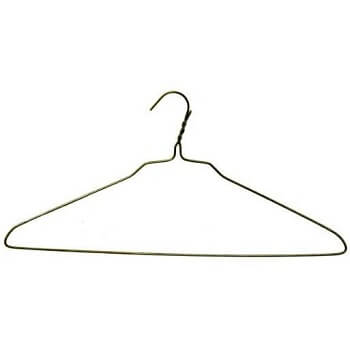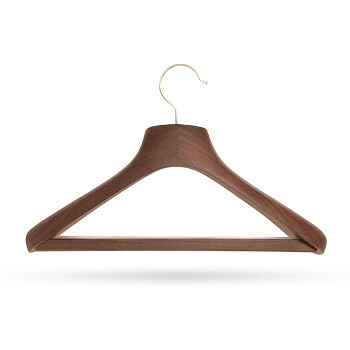The hanger is an object that has the shape of a person’s shoulders, made to make it easier to place a jacket, a blouse, a dress, a hat, or other clothes in a way that prevents them from wrinkling. Most of the hangers have a lower bar on which pants or skirts can be placed. They may also have two clamps attached to the lower bar that are used for the same purpose.
The invention of the hanger is attributed to several persons. Some historians say that President Thomas Jefferson invented an ancestor of the wooden hanger. However, the most commonly used hanger today, in the form of shoulders, made of wire, was inspired by the coat hook and was invented by O. A. North from New Britain, Connecticut, in 1869. By the beginning of 1900, they were more widely used for clothing and accessories for men and women. Today, they are an indispensable element found in any home around the world.
There are three types of hangers.
- The first type is the wire hanger, made of a simple wire, in the form of a triangle that continues with a hook at the top.
- The second type is the hanger made of wood, in the shape of a boomerang, finished and varnished so it won’t damage the clothing, with a hook (usually of metal) at the top. Some wooden hangers have a rounded lower bar that links the two ends and brings the hanger into a triangle shape.
- The third and most used type of hanger nowadays is the plastic hanger, which can reproduce the shape of the wire or wooden hanger. Plastic products are also made in smaller sizes to accommodate the shapes of children’s clothes.
The bad news is that not all of the hangers are recyclable. However, hangers that are in good shape can be reused, either for an intended purpose or by hard-working artists and crafters.
How to recycle wire hangers?
 The wire hangers are made of steel and have a thin plastic coating to prevent them from rusting. Some recycling centers will take them without any questions. However, some recycling centers have policies that prohibit the gathering of hangers, because the curved ends may get stuck inside the sorting and recycling equipment.
The wire hangers are made of steel and have a thin plastic coating to prevent them from rusting. Some recycling centers will take them without any questions. However, some recycling centers have policies that prohibit the gathering of hangers, because the curved ends may get stuck inside the sorting and recycling equipment.
Check with your local solid waste district before wrapping your metal hangers together and taking them to a recycling center. If you are lucky enough to live somewhere like New York or Riverside, you can put metal hangers in the recycling bin. But these programs are the exception to the rule. It is best to remove any paper, light cardboard, foam, or wires wrapped around the hanger before recycling them. The paper can be also recycled.
However, the chances are that foam and wire cannot be recycled. The leading suppliers of wire hangers are chemical cleaners, who use them for storing clothing before returning it to their owners.
Many chemical cleaners will take back metal hangers and reuse them. Ask about this and the plastic bags that most chemical cleaners use to cover their clothes, next time you pick up clothing. Or simply leave the hangers in the shop when you lift your clothes. If you pick up a lot of items, consider bringing your own hangers and a bag for clothing.
How to recycle plastic hangers?
There are several types of plastic hangers. There are pure plastic hangers, available in a rainbow of colors, which you can pick up at any drug store. Then there is the type used to hang clothing in retail stores, which is a combination of plastic and metal.
It is very difficult to know from which type of plastic the hangers are made of, which makes it almost impossible to recycle them. However, you can practice the other two ‘Rs’ with plastic hangers: Reduce and reuse. If a shop clerk offers to let you take the hangers home with you, just say no.
The store can put them back to use, a bonus for them because they do not have to buy new ones. Many shopping stores have big plastic packages of hangers and sell them. They can also use donated hangers to hang the clothes they sell in their shops. See if your local store is interested in old plastic hangers.
How to recycle wood hangers?
 Wood hangers are also not recyclable. Wood is treated with varnish or other types of finishing, resulting in a non-recyclable product. However, most wood hangers have small pieces of metal attached. If you can remove them, go further and place them in the metal recycling bin.
Wood hangers are also not recyclable. Wood is treated with varnish or other types of finishing, resulting in a non-recyclable product. However, most wood hangers have small pieces of metal attached. If you can remove them, go further and place them in the metal recycling bin.
Wooden hangers are best suited for coats, so consider donating the unwanted ones for charities with a lot of jackets to store and give away. Your mission is to check first with two places: health office and human service. Or, you can see if your community has a successful clothing company that provides costumes to people who need them for work interviews.
Hangers as art
The Scottish artist David Mach uses wire hangers in many of his sculptures. Hundreds of white pieces of metal come out of its white sculptures representing animals and humans, giving them a surrealistic, spinal look. An exhibition in 2012 called “precious light” at the Galway Arts Festival in Ireland featured enormous sculptures of biblical images decorated with hangers.
Hangers can be used to store objects around the house, other than clothes. Hang on them accessories such as belts, clamps, and scarves. Wooden hangers for pants are nicely hung on the wall with cut a work of art.
Wire hangers can also come in handy for boat projects. After all, if you divide them, they are, in principle, heavy-duty wire with a light plastic layer. Bent in various shapes, hangers can be transformed into garden art, butterfly wings or fairy wings for a toddler, and lighting fixtures. Or, if you feel like starting a project, a daring couple of DIYers on Pinterest will give you instructions to turn old wire hangers into shoe shelves.
You might also like to read about rubber recycling and garbage bag recycling.
Made of wire, wood, or plastic, wide as for the shoulders of the coats, thin for light blouses, with clips for skirts and trousers, they wait for you to restore their usefulness in a different form.
- Hangers dressed in fabric covers
Buy a few flowered fabric coupons, left in the stockpile baskets, or look through goods on sale at Ikea for pieces of curtains. Step two would be to measure the hangers and make a triangular pattern of clothing you will sew on your sewing machine. Put on the new skirts, especially on the old wooden hangers that look worn out or the thin ones of the wire, like those received at the cleaning store. Beyond its spring appearance, light silk blouses will no longer slip.
- Painted hangers for house and garden
Of course, we are talking about the wooden hangers that we will color with spray paint. It’s practical, the result is quick and, if you make sure to lay down some newspapers, it is without risk! They end up looking so good that you won’t want to cover them with clothing.
Using emery cloth, clean the clearcoat, dirt, or paint on the hanger. Apply a basecoat of white paint, then let it dry. If necessary, also apply the second coat of paint. When the shadow is perfectly white, prepare the tissue and cut the floral motifs on its surface using scissors. Using glue, apply the cropped images on the wood hangers. Gently press the flower onto the glue, then soften the brush into the glue again and apply the glue on the whole surface of the hanger with gentle movements.
- Hangers as racks
When I found this idea, I thought the handicraftsman won’t be so happy. In the hall, you can have a white rack with three old hangers or as many as you want.
- Hangers as magazine support
Please avoid putting them in the bathroom!
Set up a reading corner in the living room or even in the kitchen. A few nails lined up on which you will hang stronger hangers, because magazines can be heavy and deform those made of thin wire, and you have a magazine support. You will always know where your magazines, books, newspapers, cooking books are, so you won’t have them hanging everywhere.
- Hangers for pants transformed in photo holders
 Do you have a few printed photos, favorite images cut from magazines, inspiring messages, written on postings you would like to see as often as possible? If you stick them directly onto the wall, they may not look that good.
Do you have a few printed photos, favorite images cut from magazines, inspiring messages, written on postings you would like to see as often as possible? If you stick them directly onto the wall, they may not look that good.
What can you do? Paint 2-3 thin, old hangers, hang them on the wall, either using a thin nail or double-stick tape, applied discreetly so that it is not visible, and, using small colored hooks, hang your favorite images or quotes on the hanger.
Those annoying clips that never hold the pants can hold photos or small collages with your favorite images. It is a sort of thing that you can easily do and it has an aesthetic impact!
- How to transform a hanger into a holder for kitchen towels
If you want to make the space inside the kitchen more efficient, you can use a vertical stand. On one of the kitchen walls, attach a wire hanger using a fixing device – the suction cup is ideal. With a pair of scissors or wire cutters, cut the bottom of the hanger a little, then, through the hole created, hang the rolls of paper so that they stay on the remaining edges.
- Hangers as holders for jewelry or scarves
This is the last suggestion, hoping to be the first thing you will begin with your DIY project. It is such an unusual and original trick of organizing the bundle of tangled necklaces and chains, that any woman should find it at the supermarket. This support is ideal if you have many pieces of jewelry, especially long necklaces, which would get tangled with each other, rather than kept in a box.
To make space more efficient, but also to protect the jewelry you have, you can turn a hanger into a special support for them. You need a few zinc-coated steel hold screws with an open ring and a wooden hanger. All you need to do is apply hold screws from place to place, along the inside edge of the hanger. A simpler version is to place a few pits on the surface of the hanger.
How to get the hangers colored
If the wooden hangers can be redecorated with the tissue technique, the thin, wire hangers are decorated with colored strings. Choose some of your favorite threads to knit and, with them, cover the entire surface of the wire hangers. You can make them either in one shade or in more. Also, instead of colored strings, you can use pieces of colored fabric or cloth and glue.
Conclusions
What would have happened with that hanger? For what was 100g of plastic produced? For how long was used and how long does it remain on Earth? The hanger is from a PS6 material, a plastic that is not very qualitative. Anyway, it requires a large recycling process that consumes energy and other chemicals.
At the same time, supermarkets and shops are full of hangers for sale. Of course, most of them are made from plastic. Why? Why do we have plastic hangers in our supermarket for sale when there are free hangers on the sideline of the supermarket, in the recyclable area? New, almost unused, and fully functional.
This is the real problem of the world, I say. And if we solve these problems without changing the quality of life, I repeat, without changing the quality of life, we could have an extremely positive impact on the environment. Practically, nothing changes when you buy a coat if it is with or without a hanger. At 80g the simple hanger, plus its volume, how much unnecessary trash will be produced?
I am not against plastic, we need plastic – if used properly. It is an excellent material, but most of the time we see its pointless use.





